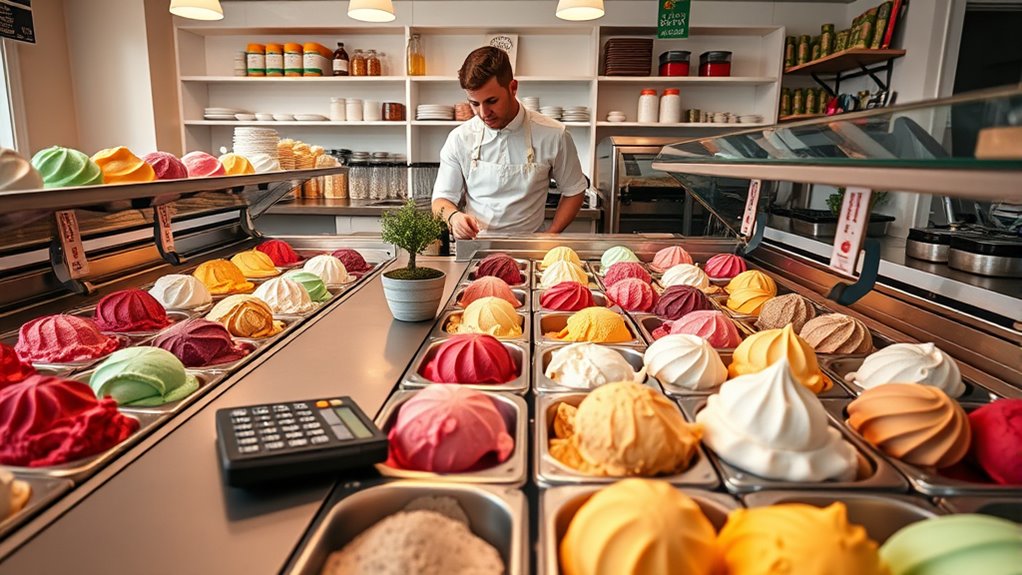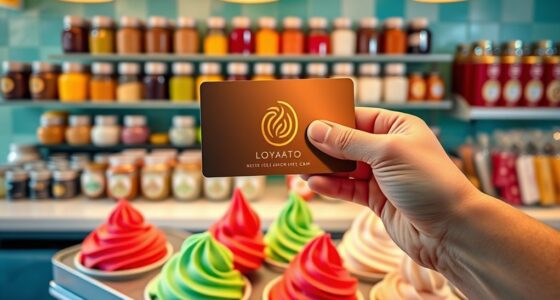To succeed in gelato production, you need to balance startup costs, equipment quality, ingredient expenses, and operational efficiency. Initial investments cover location, reliable machinery, and storage, while high-quality ingredients boost customer loyalty and profit margins. Managing ongoing expenses like labor and permits is essential for sustainability. Proper infrastructure minimizes waste and extends shelf life, improving profitability. If you want to master these financial factors and grow your business, there’s more to explore.
Key Takeaways
- Initial startup costs vary widely, influenced by location, equipment quality, and infrastructure investments.
- High-quality machinery and storage systems are essential for maintaining gelato consistency and extending shelf life.
- Ingredient costs significantly impact profit margins and depend on supplier choices and ingredient quality.
- Operational expenses like labor, permits, and marketing shape overall profitability and financial sustainability.
- Effective cost management and quality control are crucial for customer satisfaction and long-term business success.

Starting a gelato business involves significant upfront investment and careful management of costs to guarantee profitability. To succeed in gelato production, you must consider various factors that influence both expenses and quality.
The initial investment, which can range from approximately $49,500 to $228,000, covers key elements like location, equipment, inventory, and decor. Equipment plays a crucial role; investing in high-quality, reliable machinery ensures consistent gelato texture and flavor, which is vital for customer satisfaction and minimizing long-term maintenance costs. Cutting corners here might save money upfront but could lead to costly repairs or inconsistent product.
Ingredient costs are another major component affecting your profit margins. Sourcing fresh dairy, flavorings, and toppings at good quality is essential, but these costs can fluctuate based on your suppliers and the quality of ingredients you choose. Prioritizing quality ingredients might increase initial expenses, but it typically results in a better product and higher customer loyalty. Managing these costs effectively is key to maintaining healthy profit margins, especially since ingredient expenses are a significant portion of operational costs.
Operational expenses further shape your financial outlook. These include labor, licensing, permits, and marketing efforts—all of which contribute to the overall cost structure. Efficiently managing operational expenses ensures that your business remains profitable without sacrificing product quality or customer experience.
Additionally, storage infrastructure is vital for preserving gelato’s quality and extending its shelf life. Proper temperature control and freezing equipment are necessary to keep gelato at optimal conditions; any lapse in temperature control can lead to spoilage or ice crystal formation, damaging the product and reducing its shelf life. A well-designed storage infrastructure can significantly reduce waste and improve inventory management.
Investing in reliable storage infrastructure and temperature control systems might seem costly initially, but they’re essential for maintaining gelato quality and avoiding waste. The shelf life of your gelato directly affects operational expenses—longer shelf life reduces waste and allows for better inventory management.
Failing to invest in proper storage can lead to spoilage, increased costs, and compromised profit margins. Ultimately, balancing the initial investment in equipment and infrastructure with ongoing operational costs is key to sustaining a profitable gelato business.
When you prioritize quality ingredients and reliable equipment, you set a strong foundation for consistent product quality, customer satisfaction, and healthy profit margins, making your investment worthwhile in the competitive gelato market.
Frequently Asked Questions
Is a Gelato Business Profitable?
You might wonder if a gelato business is profitable. It can be, especially if you manage startup costs, keep operational expenses low, and set the right prices.
Using high-quality ingredients and efficient supply chains boosts margins. Tap into market trends for premium and health-conscious options, and diversify your flavors and sales channels.
With smart branding and innovation, you can turn your gelato venture into a profitable, thriving business.
How Much Does It Cost to Produce Gelato?
Thinking about how much gelato costs to make is like peeling back layers of a sweet onion. You’ll spend around $1 to $3 per serving on ingredients.
Equipment costs can hit $30,000 to $150,000 upfront. Labor, overhead, and extras add up, pushing your total production costs to roughly $2 to $6 per unit.
Keep these numbers in mind to better understand your profit margins and pricing strategies.
How Much Does It Cost to Start a Gelato Business?
Starting a gelato business can cost between $49,500 and $228,000. You’ll need money for location, equipment, inventory, licenses, and marketing.
Equipment expenses range from $30,000 to $150,000, while initial ingredients and packaging cost around $5,000 to $10,000.
Renovations and decor might add another $10,000 to $50,000.
Don’t forget to include a 10-15% buffer for unexpected costs, ensuring you’re prepared for the journey ahead.
What Is the Revenue of Gelato?
You’re curious about gelato’s revenue, and it’s impressive. The global market hit around USD 9.45 billion in 2023 and is expected to grow to USD 15.85 billion by 2033.
Major brands like Grom and Amorino earn hundreds of millions annually.
In Italy, gelato contributes billions through local shops and exports.
Premium artisanal gelato and expanding sales channels keep revenue rising across markets worldwide.
Conclusion
Now that you understand the costs, the pricing, and the market dynamics, you can make smarter decisions. You can control ingredients, optimize processes, and target your customers effectively. You can balance quality and affordability, manage supply and demand, and grow your gelato business confidently. By mastering these economic principles, you can create a successful, sustainable, and delicious gelato brand that stands out in a competitive world. Your journey to gelato greatness starts with understanding its economics.
















